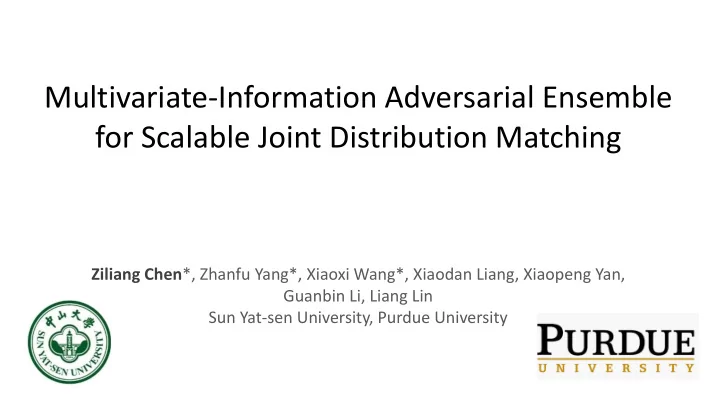

Multivariate-Information Adversarial Ensemble for Scalable Joint Distribution Matching Ziliang Chen *, Zhanfu Yang*, Xiaoxi Wang*, Xiaodan Liang, Xiaopeng Yan, Guanbin Li, Liang Lin Sun Yat-sen University, Purdue University
Motivation Implicit Generative Models (IGM), e.g., GAN [1] and CycleGAN [2], boil down to an -domain joint distribution matching (JDM): [1] I. J. Goodfellow, J. Pouget-Abadie, M. Mirza, B. Xu, D. Warde-Farley, S. Ozair, A. Courville, and Y. Bengio, Generative Adversarial Nets. Proceedings Neural Information Processing Systems Conference, 2014 [2] J.-Y. Zhu, T. Park, P. Isola, and A. A. Efros, Unpaired Image-to-Image Translation using Cycle-Consistent Adversarial Networks. ArXiv, 2017
Motivation Implicit Generative Models (IGM), e.g., GAN [1] and CycleGAN [2], boil down to an -domain joint distribution matching (JDM): However, if > 2, [1] I. J. Goodfellow, J. Pouget-Abadie, M. Mirza, B. Xu, D. Warde-Farley, S. Ozair, A. Courville, and Y. Bengio, Generative Adversarial Nets. Proceedings Neural Information Processing Systems Conference, 2014 [2] J.-Y. Zhu, T. Park, P. Isola, and A. A. Efros, Unpaired Image-to-Image Translation using Cycle-Consistent Adversarial Networks. ArXiv, 2017
Motivation Implicit Generative Models (IGM), e.g., GAN [1] and CycleGAN [2], boil down to an -domain joint distribution matching (JDM): However, if > 2, Solution 1: CycleGAN, JointGAN[3] Solution 2: StarGAN [4] and its variants They suffer combinatorial explosion in The domain-shared model lacks their parameters theoretical support, fragile in model collapse [1] I. J. Goodfellow, J. Pouget-Abadie, M. Mirza, B. Xu, D. Warde-Farley, S. Ozair, A. Courville, and Y. Bengio, Generative Adversarial Nets. Proceedings Neural Information Processing Systems Conference, 2014 [2] J.-Y. Zhu, T. Park, P. Isola, and A. A. Efros, Unpaired Image-to-Image Translation using Cycle-Consistent Adversarial Networks. ArXiv, 2017 [3] Pu Y, Dai S, Gan Z, et al. JointGAN: Multi-Domain Joint Distribution Learning with Generative Adversarial Nets ICML. 2018. [4] Choi Y, Choi M, Kim M, et al. StarGAN: Unified Generative Adversarial Networks for Multi-Domain Image-to-Image Translation. CVPR 2018.
Solution 3: ALI Ensemble A dversarially L earned I nference ( ALI ) Model [5] [5] Dumoulin, V., Belghazi, I., Poole, B., Mastropietro, O., Lamb, A., Arjovsky, M., and Courville, A. Adversarially learned inference. arXiv preprint arXiv:1606.00704, 2016.
Solution 3: ALI Ensemble ALI ensemble across domains Advantages: (1). Linear-parameter scalability as increases. (2). Generative model capability:
Solution 3: ALI Ensemble ALI ensemble across domains Advantages: (1). Linear-parameter scalability as increases. (2). Generative model capability:
JDM Criteria In supervised learning, data are drawn from , each of them presenting as – tuple. So the criterion can be written as In unsupervised learning, no access is provided to draw -tuple from . Extending the observation from [6], the criterion is to minimize the conditional entropy [6] Li, C., Liu, H., Chen, C., Pu, Y., Chen, L., Henao, R., and Carin, L. Alice: Towards understanding adversarial learning for joint distribution matching. In Advances in Neural Information Processing Systems, pp. 5501 – 5509, 2017.
Multivariate Mutual Information Mutual Information: Multivariate Mutual Information: Our method aims to achieve:
Multivariate Mutual Information Leads To JDM
Multivariate Mutual Information Leads To JDM
Adversarial Ensemble Learning s.t.
Experiments Generation Groundtruth
Experiments
Experiments Supervised Learning Unsupervised Learning
Collaborators Zhanfu Yang Xiaoxi Wang Xiaodan Liang Xiaopeng Yan Guanbin Li Liang Lin Thank You!
Recommend
More recommend